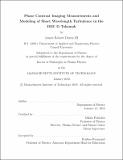Phase contrast imaging measurements and modeling of short wavelength turbulence in the DIII-D tokamak
Author(s)
Dorris, James Robert, III
DownloadFull printable version (4.484Mb)
Other Contributors
Massachusetts Institute of Technology. Dept. of Physics.
Advisor
Miklos Porkolab.
Terms of use
Metadata
Show full item recordAbstract
The DIII-D phase contrast imaging (PCI) diagnostic has been upgraded and used to measure turbulence in the outer plasma region (0.7 < r/a < 1). These upgrades extended its operational range to high frequencies (10 kHz - 10 MHz), short wavelength (2 - 30 cm-1), and improved the signal-to-noise ratio by 10X, as well as provided a novel rotating mask to measure turbulence as a function of propagation angle about the PCI chord. Turbulent fluctuations that propagate perpendicular to the magnetic field direction can be localized by making use of the variation of the magnetic field component perpendicular to the viewing chord as a function of chord height. Long wavelength (IkI . 12 cm-1) turbulence is shown to be a branch in frequency and wave-number space, and is localized to within the instrumental width of the last closed flux surface (LCFS) (r/a & 0.9). Three classes of turbulence with finite (and theoretically unexpected) kII have been identified: (i) modes that are localized in wave-number and mask angle (the high-k and medium-k modes), (ii) a broad (in mask angle) background turbulence, and (iii) a low-k "wing" that smears the main branch structure. These modes are seen to propagate at angles as large as kII/k ~ 0.1 - 0.4. ECH heating is observed to increase the spectral power density in the high-k mode (-24 < k < -18 cm-1), and the parallel wave-numbers are measured to be as large as kII/k ~ 0.15. The applied heating is shown to increase the electron temperature gradient drive (inverse scale-length, 1/LTe) and decrease the ion temperature and density gradient drives (1/LTi and 1/Ln). Using a basic temperature gradient driven drift-wave model in slab geometry, it is shown that finite (and relatively high) kII modes could interact resonantly with ions through the ion cyclotron Doppler resonance terms [xi]±1i = (w± [omega]i)/(kIIvti) ~ 1. These m = / \ 0 terms in the dispersion relation are not included in the derivation of the gyrokinetic equations.
Description
Thesis (Ph. D.)--Massachusetts Institute of Technology, Dept. of Physics, 2010. This electronic version was submitted by the student author. The certified thesis is available in the Institute Archives and Special Collections. Cataloged from student submitted PDF version of thesis. Includes bibliographical references (p. 203-212).
Date issued
2010Department
Massachusetts Institute of Technology. Department of PhysicsPublisher
Massachusetts Institute of Technology
Keywords
Physics.